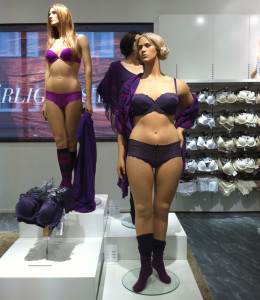Maybe you’ve seen this photo, currently making the rounds online, of larger-than-usual Swedish mannequins. Call them “plus-size” or “normal,” they’re generating a lot of attention from regular users and bloggers alike. You might wonder, “What’s the big deal? Why do we care so much whether mannequins (and models) reflect normal human body shape?” Perhaps it’s because the models we view seem to impact our self-esteem, often negatively.
Researchers in 2010 found that medically overweight women experienced lower self-esteem when viewing models of any size. Keep in mind, according to the National Institute of Health, 2/3 of Americans are overweight. The same researchers found that women with a normal BMI take a hit to their self-esteem when viewing models that were moderately heavy or extremely thin. In the study, only medically underweight women consistently felt good about themselves. The researchers recommended that “overweight consumers attempt to avoid looking at ads with any models, thin or heavy”.
Good luck with that in our culture, especially avoiding thinner models. According to multiple sources, the average size of mannequins in America is 4 or 6, while Tyra Banks noted that super models are now widely expected to be a size 0. In contrast, the average American woman is size 14. That means every time the average woman goes into a store, opens a magazine, or turns on the television, she’s likely to feel bad about herself. The research for men is scarcer, but suggests similar problems.
The real problem comes when you consider what often accompanies lower self-esteem: depression, anxiety, lower sense of self-worth, vulnerability to domestic violence, and other mental and behavioral health issues. Add in anorexia (the deadliest diagnosis in psychiatrists’ Diagnostic and Statistical Manual of Disorders), bulimia, and general body image issues, and the question starts to look less like, “Why do we care so much?”, and more like “Why don’t we care much more than we do?”.
Psychotherapy can certainly help people address all of these issues, including improving self-image and self-esteem and helping people find ways to be more resistant to the impacts of media and marketing messages. Therapists can work with clients to be more accepting of their body shape and, when appropriate, help people develop and commit to plans for achieving better health and fitness. And, while anorexia and bulimia clearly have major medical consequences, they are most often psychological issues at their core and therefore benefit from integrating mental health counseling into the treatment plan.
As a society and culture, we can begin actively requesting that models (including mannequins) and advertisements reflect diverse, healthy human body shapes. This can be as simple as retweeting, resharing, and commenting on things like the picture above. For those interested in more direct action, consider submitting an opinion piece to your local paper, writing to your favorite fashion or lifestyle magazine, or making a comment to a manager at your favorite clothing or department store. It is possible for us to move away from a culture that glamorizes impaired health and towards one that models healthy body shapes.


